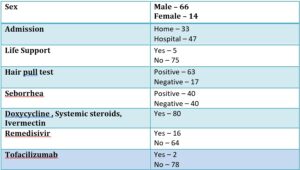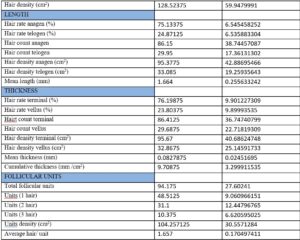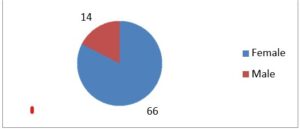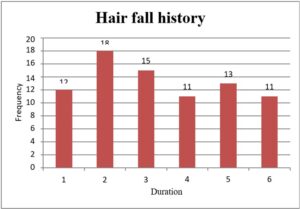Mahajabeen Madarkar1*, Sushila Nagur2, D Purshotam B1
1Associate Professor and Head of the Department, SR Patil Medical College, Badagandi, Bagalkote, India
2Senior Resident, SR Patil Medical College, Badagandi, Bagalkote, India
*Correspondence author: Mahajabeen Madarka, Associate Professor and Head of the Department, SR Patil Medical College, Badagandi, Bagalkote, India; Email: [email protected]
Published Date: 06-08-2024
Copyright© 2024 by Madarka M, et al. All rights reserved. This is an open access article distributed under the terms of the Creative Commons Attribution License, which permits unrestricted use, distribution, and reproduction in any medium, provided the original author and source are credited.
Abstract
Background: Across the globe from December 2019 until today (COVID -19) has rapidly spread causing pandemic. We have obsevered acute hair loss (TE) in intiating 3-4 months of post COVID infection. Telogen effluvium is a diffuse, non scarring shedding of hairs, resulting from the early entry of the hairs into the telogen phase. Classic TE is self limited and acute, defined as lasting less than 6 months. Trichoscopy is a simple and non invasive technique that can be performed with both handheld dermatoscope and digital videodermoscopy system. Trichogram is simple minimally invasive rapid and economic technique for measuring hair follicle activity.
Objective: To assess hair loss occurring after COVID-19 infection. The aim of our study is to assess hair loss occurring after COVID-19 infection using trichoscopy and trichogram to investigate the possible findings related to COVID 19 infection.
Materials and Methods: Prospective, observational study included 80 patients with post COVID TE.
Results: Out of 80 patients, hairpull test was positive in 63%. Trichogram parameters showed positive telogen effluvium in 70 patients (as the rate was more than 20%) with anisotrichosis.
Conclusion: In the current era, SARS-CoV-2 infection should be suspected in a patient who presents with acute TE. This study shows some variations in the trichoscale as hair density had significantly decreased in 70 patients. Dermoscopic features suggested of peripilar sign, yellow dots, anisotrichosis and perifollicular scaling as the diagnostic criteria.
Keywords: Post COVID; Telogen Effluvium; Trichogram
Introduction
Across the globe from December 2019 until today (COVID -19) has rapidly spread causing pandemic [1]. Though the most common symptoms are fever, malaise, cough and pneumonia clinicians have focused on recognition of cutaneous involvement in the course of COVID-19. Cutaneous signs, including chilblain-like, maculopapular and vesicular lesions, urticaria, are frequently reported but their classification is debated [1]. A recent study has detected SARS-CoV-2 in the sweat glands and sweat ducts of COVID-19 patients [2]. In the era of COVID-19 pandemic, TE has become a common sequela, which seriously affects the psychosocial condition of patients recovered from COVID-19. Also, the COVID-19 epidemic has an impact on people’s social life and some are more prone to anxiety and depression, from which TE may occur [2]. We have observed acute hair loss (TE) in intiating 3-4 months after post COVID infection. Telogen effluvium first described bykligman in 1961, is a diffuse, non scarring shedding of hairs, resulting from the early entry of the hairs into the telogen phase [1,3]. It is characterised by diffuse hair loss within month of systemic stressor because of premature follicular transition from the anagen (active growth phase) to telogen (resting phase) [4]. The degree of effluvium depends on the severity and duration of exposure, rather than on the type of agent [5]. Classic TE is self limited and acute, defined as lasting less than 6 months and occurs approximately 3-4 months after a triggering event. Chronic form of TE is reported, exceeding 6 months of duration several agents have been associated with TE, including drugs, physiological stress, emotional stress, chronic infections, dietary and iron deficiency and smoking [1].
Trichoscopy is a simple and non invasive technique that can be performed with both handheld dermatoscope and digital videodermoscopy system [6]. The magnification with videodermoscope are 20 fold to 140 fold. It is still under utilized to rapidly differentiate clinically frequent hair disorders. The method allows quick identification of hair and shaft abnormalities without the need of hair sampling for ex-vivo evaluation, i.e., optical or scaring electron microscopy. It is also a helpful tool in differential diagnosis of common acquired hair diseases. Trichogram was first described in the literature in 1964 [7]. It is simple minimally invasive rapid and economic technique for measuring hair follicle activity. The trichogram is a useful complementary tool for clinical evaluation diagnosis and monitoring of the treatment response [7]. As we are observing many cases following 1-3 months of COVID-19. The aim of our study is to assess hair loss occurring after COVID-19 infection using trichoscopy and trichogram to investigate the possible findings related to COVID 19 infection. This study is being done for the 1st time in the Asian sub content.
Material and Methods
Eighty patients aged from 19 to 62 years wereunder our supervision. Theinclusion and exclusion of patients in the study were as follows:
Inclusion Criteria
- All clinically confirmed cases of post COVID telogen effluvium
- All patients above 16 years post COVID TE within 6 months
- Subjects giving consent to participate in the given study
Exclusion Criteria
- Patients with history of diabetes mellitus, hypertension, cardiovascular risk factors
- Patients with on going pregnancy and Lactation
- Patients affected with other viral diseases
- Patients less than 15 years
- Patients not willing for the study
- Study design: Prospective, observational study included 80 patients with post COVID TE
- Source of study population: Post COVID TE patients coming to skin OPD in HSK hospital
- Sample size and its calculation: Sample size estimation was done using openepi software version 2.3.1.
At 95% confidence level, according to the study conducted by Dominguez-santas M, et al., TE was the reported in 27.9% of Post COVID infection patiets%=p.
At 10%, absolute precision,
Sample size estimated is 78 = 80.
Hence 80 study subjects with post COVID TE will be included.
Formula used n= [DEFF*Np(1-p)]/(d2 /Z2 1-α/2*(N-1)+p*(1-p)]
Method
Ethical committee approval was taken. Patients presenting with post COVID telogen effluvium were included in the study. Informed consent was taken before examination with detailed history and examination included hair pull test, trichoscopy and trichogram was done. The patient was asked to sit on the chair for 10 min with hair open, trichoscopy was done from the mid-frontal, temporal, vertex and from occipital region. Among that mid-frontal region was taken for trichogram study. Data was collected and analysed with trichogram parameters.
Results
Evaluation of the efficacy was according to trichoscopy and mainly by trichogram parameters. Out of 80 patients, 66 (82.5%) patients were females and 14 (17.5) were males. The hairfall history of 1 to 6 months were under the study following post COVID history of 3 to 6 months. The maximum hairfall history was from 2 months with post COVID history of 6 months. In 80 patients 47 (58.8%) were hospitalized and 33 (41.3%) took treatment at home for COVID infection. In that, all 80 patients were treated with Systemic steroids, Doxycycline and Ivermectin. But few patients had history of other drugs like intravenous. Remedisivir in 16 (20%) patients, Tofacilizumab in 2 (2.5%) and life support in 5 (6.3%) patients. Hairpull test was positive in 63 (78.8%) and negative in 17 (21.3%) of patients. Seborrhea was checked, which was positive in 40 patients and negative in 40 patients. Trichogram parameters showed positive telogen effluvium in 70 patients as the rate was more than 20%, out of that patients who had taken remedisivir and tofacilizumab showed more decrease in hair density compared to other patients. Dermoscopic features suggested of peripilar sign in 60 patients (75%), yellow dots in 45 patients (56.2%), perifollicular scaling in 51 patients (63.75%) and single hair containing follicular unit in the frontal area in 18 patients (22.5%) as the diagnostic criteria. We also found purpuric dots and purpuric globules in 5 patients (6.3%). The following parameters were assessed and the results were taken by mean and standard deviation. Hair count was 116.1±54.15, hair density was 128.52±59.94 and total follicular units were 94.175±27.60 suggestive of anisotrichosis (Fig. 1-9, Table 1,2).
Discussion
According to our observations, COVID-19 TE occurred earlier than classic acute TE. Our cases showed hair loss between 1 to 6 months after the onset of SARS-CoV-2 infection, while in classic TE, this is usually observed after 3-4 months [1]. On the other side, trichoscopic features and trichogram results in our patients showed variations from classic TE. Evidence of TE in the setting of COVID-19 is currently limited and consists in a few reports [1]. Domínguez-Santás, et al., were the first to report a case of acute TE, occurring 3 months after SARS-CoV-2 infection and have been followed by additional authors, who described TE after COVID-19.

Table 1: It shows total number of patients in the study with sex, admission, life support, hairpull test, seborrhoea and drugs taken during COVID infection.

Table 2: It indicates trichogram scale values of all 80 patients which was done by calculating Mean±Standard deviation of each parameters.

Figure 1: Shows Male:Female ratio.

Figure 2: Shows hairfall history with duration and frequency of 80 patients.

Figure 3: It shows duration and frequency of COVID complaints of all 80 patients.

Figure 4: It shows trichgram scale parameters of all 80 patients with mean±standard deviation values.

Figure 5: Clinical image of post COVID telogen effluvium.

Figure 6: Tricoscopic image showing empty hair follicles (black arrows).

Figure 7: Tricoscopic image showing peripilar sign (blue arrows).

Figure 8: Tricoscopic image showing perifollicular scaling (black arrows).

Figure 9: Image of single hair showing club shaped white bulb with normal shaft.
Discussion
According to our observations, COVID-19 TE occurred earlier than classic acute TE. Our cases showed hair loss between 1 to 6 months after the onset of SARS-CoV-2 infection, while in classic TE, this is usually observed after 3-4 months [1]. On the other side, trichoscopic features and trichogram results in our patients showed variations from classic TE. Evidence of TE in the setting of COVID-19 is currently limited and consists in a few reports [1]. Domínguez-Santás, et al., were the first to report a case of acute TE, occurring 3 months after SARS-CoV-2 infection and have been followed by additional authors, who described TE after COVID-19.
High levels of IL-6 act on the hairfollicle, inducing the catagen phase as well as causing local inflammation and collapse of the immune privilege. It has been shown that high levels of IL-4, which are typical of COVID-19 in the elderly, also determine keratinocyte apoptosis in hairfollicle. Moreover, direct viral damage to HFs may be hypothesized in COVID-19 TE owing to the early onset of TE after SARS-CoV-2 infection.
We hypothesized that SARS- CoV-2 may determine direct effects on the hairfollicle via the Antibody-Dependent Enhancement (ADE) phenomenon as previously reported for other viral diseases [1]. The method allows in-vivo visualization of the epidermal portion of hair follicles and perifollicular epidermis and hair shaft at higher magnification and performing measurements such as hair shaft thickness, without the need of removing hair for diagnostic purposes.
Hair density and hair shaft diameter are the most used indicators in quantitation evaluation and the percentage of vellus hair (<30µm) has also been involved in the studies mentioned. Dermoscopic features suggesting yellow dots corresponds to dilated follicular infundibulum filled with keratotic material and/or sebum, peripilar sign seen as subtle brown halo is a specific finding, seen in early stages and reflects perifollicular lymphocytic infiltration, whereas perifollicular scaling corresponds to perifollicular hyperkeratosis [8]. In our study, we found peripilar sign in 60 patients (75%), yellow dots in 45 patients (56.2%), perifollicular scaling in 51 patients (63.75%).
The current hypothesis supporting the pathogenesis of post COVID TE is vasculitis of peribulbar capillaries causing perifollicular lymphocytic infiltration which stops the hair cell cycle. In support of this we found purpuric dots and globules in 5(6.3%) patients which has not been mentioned in previous studies.
Conclusion
In conclusion, we reported 80 cases of new-onset acute COVID-19 TE occurring between 1 to 6 months after SARS-CoV-2 infection. This study showed some variations in the trichoscale, remarkably trichogram parameters was positive for telogen effluvium as the rate was more than 20%, with dermoscopic features showing of yellow dots, peripilar sign, empty hair follicles, perifollicular scaling and single hair containing follicular unit in the frontal area.
Conflict of Interests
The authors declare that there is no conflict of interest for this paper.
References
- Rossi A, Magri F, Sernicola A, Michelini S, Caro G, Muscianese M, et al. Telogen effluvium after SARS-CoV-2 infection: a series of cases and possible pathogenetic mechanisms. Skin Appendage Disord. 2021;7:377-81.
- Lv S, Wang L, Zou X, Wang Z, Qu B, Lin W, et al. A case of acute telogen effluvium after SARS-CoV-2 infection. Clin Cosmet Investig Dermatol. 2021;14:385-7.
- Klingman A. Pathologic dynamics of human hair loss. I. Telogen effluvium. Arch Dermatol. 1961;83:175-98.
- Mieczkowska K, Deutsch A, Borok J, Guzman AK, Fruchter R, Patel P, et al. Telogen effluvium: a sequela of COVID-19. Int J Dermatol. 2021;60(1):122-4.
- Grover C, Khurana A. Telogen effluvium. Indian J Dermatol Venereol Leprol. 2013;79:591-603.
- Rudnicka L, Olszewska M, Rakowska A, Kowalska-Oledzka E, Słowińska M. Trichoscopy: A new method for diagnosing hair loss. J Drugs Dermatol: JDD. 2008;7:651-4.
- Serrano-Falcón C, Fernández-Pugnaire MA, Serrano-Ortega S. Evaluación del pelo y cuero cabelludo:tricograma. Actas Dermosifiliogr. 2013;104:867-76.
- Jain N, Doshi B, Khopkar U. Trichoscopy in alopecias: diagnosis simplified. Int J Trichology. 2013;5(4):170-8.
Article Type
Research Article
Publication History
Received Date: 07-07-2024
Accepted Date: 29-07-2024
Published Date: 06-08-2024
Copyright© 2024 by Madarka M, et al. All rights reserved. This is an open access article distributed under the terms of the Creative Commons Attribution License, which permits unrestricted use, distribution, and reproduction in any medium, provided the original author and source are credited.
Citation: Madarka M, et al. After Math of COVID Through Eyes of Tricoscopy. J Dermatol Res. 2024;5(2):1-10.

Figure 1: Shows Male:Female ratio.

Figure 2: Shows hairfall history with duration and frequency of 80 patients.

Figure 3: It shows duration and frequency of COVID complaints of all 80 patients.

Figure 4: It shows trichgram scale parameters of all 80 patients with mean±standard deviation values.

Figure 5: Clinical image of post COVID telogen effluvium.

Figure 6: Tricoscopic image showing empty hair follicles (black arrows).

Figure 7: Tricoscopic image showing peripilar sign (blue arrows).

Figure 8: Tricoscopic image showing perifollicular scaling (black arrows).

Figure 9: Image of single hair showing club shaped white bulb with normal shaft.

Table 1: It shows total number of patients in the study with sex, admission, life support, hairpull test, seborrhoea and drugs taken during COVID infection.

Table 2: It indicates trichogram scale values of all 80 patients which was done by calculating Mean±Standard deviation of each parameters.


